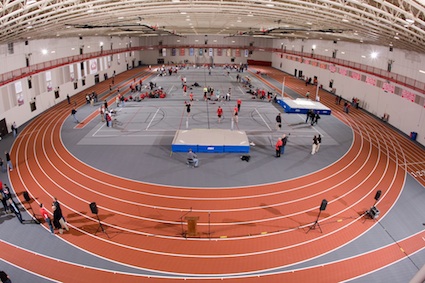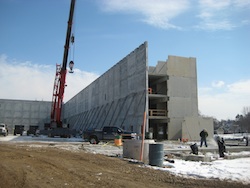Two-In-One Building Concept Maximizes Construction Funds

Budgets are tight in today’s tough economic climate and colleges and universities, like all institutions, are squeezed for funding. But the demand for new facilities — student housing and expanded student facilities — continues to grow. The challenge is to maximize every construction dollar spent.
North Central College (NCC) in Naperville, Ill., meets that challenge with a unique two-buildings-in-one solution that can serve as a prototype for educational institutions nationwide. The college’s 201,000-square-foot Res/Rec Center, completed in the fall of 2009, consists of a rectangular residence hall facility surrounding an internal activity and track center. The four-story, 265-bed dormitory wraps around a 62,000-square-foot field house like a 34-foot-wide rectangular donut.
Designed by Joliet, Ill.-based Buchar, Mitchell, Bajt Architects, Inc. the completely precast concrete structure features double-wall sandwich panels containing bio-based insulating foam to form residence hall walls, floors and ceilings. For the internal field house, 50-foot-tall precast walls and 180-foot-span roof trusses allow for an open-spaced 200-meter indoor track, activity courts and a suspended walking track. North Central College served as general contractor.
In addition to the precast components from Naperville-Ill.-based Dukane Precast Inc., the building features energy-efficient windows, radiant heat, high-efficiency air conditioning, heat recovery ventilators, a domestic hot water waste heat recovery system, a white membrane roof to reduce the heat island effect, low-flow plumbing fixtures and extensive use of recycled materials. It also capitalizes on low-emitting materials, uses materials with recycled content, and diverted most construction waste through recycling. In addition, the project features one of the largest geothermal installations in the Midwest as well as underground double-wall storm water retention tanks.
The facility qualified for a LEED Silver rating with a total of 36 points.
Energy savings during the first year of operation have been substantial, according to Mark E. Nussbaum, PE, of Architectural Consulting Engineers.
“We compared the actual building first-year energy consumption to that predicted in our LEED energy model and got results that correlated to within about 5 percent of actual usage. Comparing the actual first-year energy consumption of the building to that predicted in the standard baseline ASHRAE 90.1-2004 structure, we achieved an energy reduction of 21 percent and an energy cost reduction of 21.3 percent,” he said.
Actual dollar savings for the school totaled $65,000, based on an energy rate of $0.087 per kwh.
The geothermal system has a thermal production capacity of approximately 300 tons (3,600,000 Btu/h). The system provides chilled water for cooling resident rooms, hot water for heating resident rooms with radiant heat and all domestic hot water in the building, and water-to-air heat pumps for ventilation and HVAC of general use spaces other than the residential areas.
The domestic hot water heat recovery system captures energy from water going down the shower and sink drains and transfers it to the incoming cold water feeding the water heaters. This system saves approximately 450,000 Btu/h in required system capacity and resulting energy consumption.
Two Buildings in One
The two-buildings-in-one concept means that there is need for only one exterior façade and only one heating and cooling system for both facilities, according to Brian Bock, VP of sales and marketing for Dukane Precast. Surrounded by resident rooms, the center track facility stays cooler in summer and warmer in winter, saving on energy. In fact, there is no need to heat the interior rec center. Additionally, locating the resident rooms on the outside of the structure leaves the twin facility with a pleasing residential look. In addition, maintenance is required on the exterior of only one structure, rather than two, and the dual structure makes efficient use of scarce available land.
Officials from the building and design team said the two-in-one concept can be applied to other building uses in other areas of the country and envision dorm rooms that could surround a performing arts center, library or even classrooms.
Engineered Precast Concrete 
The facility initially provides 159 dorm rooms housing 265 students. However, it can be configured to accommodate 229 rooms with 365 beds in the future by opening rooms on the fourth floor as school enrollment grows. Rooms measure 11 feet 4 inches by 18 feet and can be single or double occupancy. Each resident room is a six-sided box with five of the six sides made of precast concrete — two side walls, the outside wall, floor and ceiling are made of engineered precast double-wall sandwich panels from Dukane. Only the wall that faces the hallway consists of metal studs and fire-rated drywall. The precast walls and ceiling panels have paintable, smooth finish surfaces that do not require drywall. Floors feature a tile covering.
The open, clear-span recreation center is surrounded by 50-foot-tall, 12-foot-wide, 12-inch-thick precast, pre-stressed concrete sandwich panels and is spanned by 180-foot-long steel trusses set every six feet. The center houses a 200-meter, six-lane indoor track, a suspended walking track, lockers, exercise equipment and multipurpose courts for basketball, tennis and volleyball.
The dormitory double-wall panels feature two 2-inch concrete faces on either side of a 3-inch layer of bio-based insulating foam (polyisocyanurate made from soybean or castor oil). Form liners were used during casting of the exterior wall panels to create, using masonry paints, the look of hand-laid brick with stone details at window headers and building corners, and make the structure compatible with the adjacent brick Merner Field House structure.
Rated at about R19, the walls provide excellent energy efficiency. In addition, the double-wall sandwich panels dramatically reduce air infiltration, offer a high level of soundproofing, provide fire resistance, and can actually withstand an EF-5 tornado with winds over 250 mph.
“The fact that you will have an above-ground tornado shelter on the campus is an added benefit to the college,” Bock said. “You get sustainability and energy efficiency, but the big bonus for the college is the life-safety factor. The structure offers incredible fire and wind protection. In effect, we have created a safe haven on the campus.”
The building’s precast components were erected in only 8 months.
Precast concrete sandwich panels are also used to form underground storm water retention tanks, both adjacent to the building and under a nearby site covered over with a tennis court.
Energy Saving Features
At the time of completion, Bock estimated that the NCC building would use 21 percent less energy than a standard baseline structure of similar size and would qualify for four LEED credits for optimizing energy performance. His projections were on target.
Energy saving features include:
• A tight building envelope with energy efficient windows and insulated precast concrete sandwich panels provides low air infiltration, thermal mass benefits and an R19 energy rating.
• An in-floor radiant heating system is used throughout the dormitory area. The recreation area is heated and cooled by forced air utilizing heat pumps, high efficiency air conditioning, MERV-11 air filters and heat recovery ventilators that capture energy from the exhausted air and transfers that energy back into the outside air brought in for ventilation. There are no boilers. In fact, there is no natural gas line to the building at all.
• Copper tubing wrapped around wastewater pipes captures the used water heat and transfers it to fresh water for reuse.
• Energy efficient fluorescent lighting combines with individual room thermostats and motion-sensor lighting controls to allow three levels of illumination.
• To reduce the heat island effect and further increase energy efficiency, the roof consists of a white membrane adhered directly to the composite roof deck panels above the field house and also atop the precast concrete panels over the dormitory area. Installed over the field house, the composite Tectum panels are highly energy efficient, 7-inch-thick composite panels consisting of a substrate, expanded polystyrene insulation and OSB sheathing.
Emphasis on Sustainability
Nearly all the manufactured materials used in the project were produced within 500 miles — and many within 10 miles — of the building site, including the precast panels, cement aggregate and stressing steel. According to the project’s LEED consultant, the project’s materials contain a total of about 15 percent recycled content and 70 percent of construction waste was diverted through recycling. In all, about 47 percent of materials used in the project were regionally sourced.
To reduce water use, the Res/Rec Center features low-flow toilets, water efficient fixtures, hand dryers, water-conserving indoor and outdoor plants, and no irrigation system. Water usage was reduced a total of 25 percent. Low-emitting materials were selected for adhesives, sealants, paints and carpets. The building was flushed at 14,000 cubic feet per minute at the end of construction to remove any gasses emitted by the new materials.
The project also makes use of geothermal energy and incorporates a geothermal field with 60 geothermal wells, each 650 feet deep, making it one of the largest geothermal projects in the Midwest.
Even the Concrete is Green
One of the key environmentally friendly features, says Bock, is the concrete mixture itself. Slag aggregate, which is a waste product, is used as a substitute for virgin limestone. In the factory, the self-compacting, 6,000-psi concrete mix incorporates 60 percent vacuum-saturated slag aggregate. On average, fly ash and slag cement replaced about 30 percent of the Portland cement in the precast concrete panels. Overall, the precast panels are made with about 40 percent recycled materials.
Even with an extensive array of green products and technology, including the installation of geothermal wells, Buchar estimates a seven- to nine-year payback on the green technology.
“With a 50-plus-year building, if you can get everything paid back in less than 20 percent of the building life span, you’re doing very well,” he said.
Finally, Bock maintains, building the two-buildings-in-one structure with 50-foot-tall internal walls in the extremely tight timeframe could likely only be accomplished economically with precast concrete.
“Time, from start to completion of the shell, totaled only about ten months,” he notes. “So, in my opinion, precast concrete construction made the project possible to meet the timing needs of NCC.
“And that,” he adds, “Is the bottom line.”
